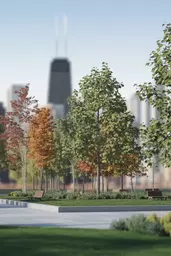Sound Absorption
Tree canopies absorb sound waves, significantly reducing noise levels.
Subscribe to get expert tips and the latest insights on tree care and urban greening directly to your inbox.
Posted on: 2025-05-29
By: Keira Vallejo
Imagine stepping into a bustling city, where the clamor of traffic and chatter overwhelms your senses. Now, picture a serene oasis, softened by the whisper of leaves and the rustle of branches. This transformation is not just a dream; it can be achieved through the strategic use of urban trees, which are powerful allies in combating noise pollution.
Urban trees function effectively in reducing noise pollution through various mechanisms, enhancing both our environment and quality of life.
Tree canopies absorb sound waves, significantly reducing noise levels.
The intricate structure of trees helps to diffuse sound, making environments quieter.
Strategically planted trees can act as effective barriers against urban noise pollution.
Trees contribute positively to our mental well-being while reducing noise.
When you step outside in the city, have you ever noticed how the sounds of honking cars and bustling crowds can be overwhelming? This is urban noise pollution, a common issue in our fast-paced environments. Thankfully, trees play a crucial role in lessening this noise, making our urban landscapes more peaceful and enjoyable.
Understanding the impact of noise pollution on our lives is essential. It can lead to increased stress and even health problems. That's why I love discussing how we can use our green spaces, like the ones we promote at Urban Canopy Blog, to improve our communities.
Firstly, let's define urban noise pollution. It's the constant, unwanted sounds we experience in cities, primarily from traffic, construction, and industrial activities. These sounds can be disruptive and lead to serious consequences for our well-being. One aspect that is often overlooked is how noise pollution affects mental health, and this is where urban trees can truly make a difference.
The sources of noise pollution include:
All of these contribute to a noisy environment that can be stressful and irritating. Urban communities often experience higher levels of anxiety and other health issues because of this constant noise.
The effects of noise pollution can be quite serious. Studies show that prolonged exposure can lead to sleep disturbances, increased heart rates, and even decreased productivity. It's not just about annoyance; it can impact our day-to-day lives significantly!
Additionally, noise pollution can affect our social interactions. When it's hard to hear each other, it diminishes the sense of community. So, how can we combat this problem? Urban trees may be the answer! And to ensure these trees are well taken care of, professional tree care is essential; you can read more about the benefits of professional tree care.
Now, let's dive into how trees help reduce noise pollution. They do this in several fascinating ways. First, they can absorb sound, which helps muffle the noise around them. This is where tree canopies play a vital role!
Here are some mechanisms by which trees work their magic:
By incorporating more trees into our cities, we can create a calmer atmosphere that benefits everyone!
The primary way trees reduce noise is through sound absorption. Their canopies act like a giant sponge, soaking up sound waves and preventing them from bouncing around. This is especially important in busy urban areas where noise levels can be overwhelming.
Think about the next time you're near a park! The sounds of nature can drown out the hustle and bustle of city life, making it a sanctuary for relaxation. Isn’t that wonderful?
Beyond absorbing sound, trees also scatter it. Their unique structures—thick trunks and sprawling branches—help spread sound waves, which lowers their intensity. This means that when you're standing under a tree, you might notice it's quieter than in open spaces.
This is something we should keep in mind when planning urban landscapes. Choosing the right tree species can make a significant difference!
Another fantastic aspect of trees is their ability to function as natural barriers. When planted strategically along busy roads, they can block noise from reaching our homes and parks. This not only creates a more tranquil environment but also enhances the beauty of our urban spaces.
Imagine walking through a street lined with trees, where the sounds of the city fade away. That’s the magic of urban forestry, and it's something I deeply advocate for at Urban Canopy Blog!
Lastly, let's touch on the concept of acoustic ecology. This involves understanding how sound interacts with the environment, including urban settings. Trees contribute positively to our soundscape, making the auditory experience richer and more pleasant.
By planting more trees, we can enhance not just the visual but also the auditory appeal of our cities. Who wouldn’t want to live in a place that feels good to the ears and eyes?
Now that we've explored how trees combat noise pollution, let’s look at which types are best suited for this purpose. Different species offer various benefits, making it essential to choose wisely!
The best types of trees for noise reduction include:
Choosing the right trees can lead to not just a quieter environment but a healthier and more vibrant one too!
Here's a brief recap of the key points discussed so far:
As we draw our discussion to a close, it’s clear that urban trees play a vital role in reducing noise pollution. They not only enhance our city landscapes but also serve as natural sound barriers. By understanding the mechanisms through which trees operate, we can fully appreciate their importance in creating healthier urban environments.
From sound absorption to creating natural barriers, trees offer a multitude of benefits that go beyond mere aesthetics. They help in muffle noise, scatter sound waves, and provide a soothing backdrop to our daily lives. So, the next time you walk by a row of trees, remember that they are more than just green giants; they are guardians of peace in our bustling cities.
Let’s recap some key takeaways on how urban trees contribute to noise control:
By integrating these natural wonders into our urban planning, we can create communities that are not only quieter but also healthier! At Urban Canopy Blog, we emphasize the importance of selecting the right tree species for maximum acoustic benefits.
When considering trees for noise reduction, certain species stand out for their unique characteristics:
Choosing the right tree species not only enhances the beauty of our urban spaces but also maximizes their noise-reducing potential. It’s a win-win for both the environment and the community!
As we move towards a future where urban noise management becomes increasingly important, the role of trees will only grow. Sustainable urban planning that incorporates green infrastructure is essential for tackling noise pollution effectively.
We must advocate for more green spaces within our cities. This can be achieved through policies that support urban forestry initiatives. It’s not just about planting trees; it’s about creating environments where both people and nature can thrive!
Looking ahead, the future of urban forestry will focus on innovative strategies to manage noise pollution. This involves:
Through these efforts, we can cultivate urban environments that are not only quieter but also more vibrant and enjoyable for everyone!
Now, it’s time for action! Let’s work together to advocate for more green spaces in our urban areas. You can get involved by:
By taking these steps, we can nurture our urban forests and contribute to a healthier, quieter community. Let’s make our cities greener, one tree at a time!
Finally, community engagement is crucial for the success of urban tree planting initiatives. When residents come together, they can:
At Urban Canopy Blog, we believe that everyone has a role to play in enhancing our urban landscapes. Let’s unite for greener cities and healthier lives! One important aspect of ensuring the longevity and effectiveness of these trees is understanding and implementing proper summer tree care tips for cities.
Here is a quick recap of the important points discussed in the article:

 In urban environments, trees are often the unsung heroes contributing to our well-being and the over
In urban environments, trees are often the unsung heroes contributing to our well-being and the over
 Urban trees are essential to our cities, yet they face numerous threats from pests and diseases. Did
Urban trees are essential to our cities, yet they face numerous threats from pests and diseases. Did
 Did you know that urban tree diversity is crucial not just for aesthetics, but for the health of ent
Did you know that urban tree diversity is crucial not just for aesthetics, but for the health of ent